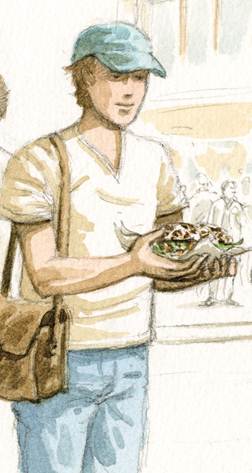Gustain

Gustain, the young bread-tasting reporter, savouring a Dutch Crunch Sandwich, in a street of San Francisco.
Gustain's Travel, from Morocco to Russia
We often assume we know just about everything about the world of bread simply because we eat it every day. The French even see themselves as the inventors. Even so, it just takes a quick glance at our history books, an excursion into the world of “bread eaters” – the term Homer used when he talked about the Greeks – to quickly understand that bread is part of everybody’s heritage. It is what sets agricultural civilization apart from others, and each people has its own way of making it its very own.
As Gustain -- a young, bread-tasting reporter who enriched the long history of bread through his travels around the world – discovered, peoples around the globe have developed their own recipes, their own symbolism, their own mythology, and their own rituals around this identifying object par excellence. Is it possible to find another object with which more peoples are familiar than bread, an object that expresses who the Indians, Mexicans, Georgians, Egyptians, Peruvians, French, Iraqis, and even Asian peoples truly are? That’s what we’re going to delve deeper into here.
The grains used, or sometimes roots or tubers; the methods of fermentation and cooking; the symbolism that each bread holds; the methods of fermentation and cooking; the food traditions, and this glossary Around the World with 80 Breads, should help differentiate the wealth of this bread baking “palette”, represented in this totally unprecedented list of 80 different breads. The rules of the game were that Gustain had to choose ONE bread, and only one, from each country he visited, and that made his job difficult. One bread amongst an infinity of shapes, flavors, and recipes, used to measure the inventiveness of a people and their genius.
Eighty breads, eighty countries: ambassadors of a long, shared odyssey that started in Mesopotamia some 10,000 years ago. The bread route therefore started in what we now call Iraq, and then spread to all continents. With the sketches of Jean-François Barbier, and the pen of Jean-Philippe de Tonnac, Gustain has proven to be a tireless traveler.
When I was a young mountain dweller only 15 years of age, I one day got a job in a bread bakery to earn a little pocket money. Little did I know that this job would open a whole new world to me, a world I would end up devoting my life’s physical and entrepreneurial energy to. Bread helps retrace the steps of the history shared with the very first farmers and those who descended from them, but it also tells of a “covenant” which is in my mind sacred: the “covenant” of the miller, passionate about his work, unflagging in his devotion to it; of the baker, who must guide the bread along its path, from fermentation and properly monitored cooking, until he achieves the level of perfection desired.
I created my company, Eurogerm, because I cared about this sacred covenant, and wanted to support it. I wanted to revive the job of milling and bread baking that we have been supporting and defending since 1989, and for which we are driven to reach out endlessly in the name of quality. Around the World with 80 Breads expresses our continued, international outreach to the field. We are represented on all five continents; we’ve had to learn to pronounce the word “bread” in almost all languages. Our employees work in the service of this wealth and diversity with an unceasing passion. They are the essential ingredients of this trip Around the World with 80 Breads. Through this work, I want to share our wealth with you. Bon voyage!
Jean-Philippe Girard
Chief Executive Officer of Eurogerm
